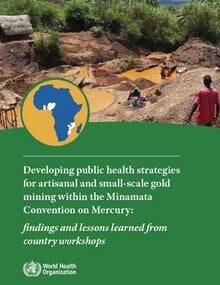Overview
Mercury amalgamation remains the preferred method to extract gold employed in artisanal and small-scale gold mining (ASGM) worldwide. Liquid elemental mercury is added to an ore slurry to bind to gold and form a gold–mercury complex (amalgam). When gold is separated from mercury in the smelting process, high concentrations of mercury vapours are released. People working and living in ASGM communities are exposed to mercury mainly through inhalation of these toxic vapours. Furthermore, mercury dust is deposited on surfaces (walls, clothes, tools) and released to the environment, where microorganisms in water and soil convert elemental mercury into organic methylmercury, which accumulates in the food chain.
To support ministries of health develop their detailed public health strategies for inclusion in the national action plans (NAPs), WHO, in collaboration with the Swiss Tropical and Public Health Institute, developed a research approach. The approach was pilot-tested in three African countries – Ghana, Mozambique and Nigeria – that have extensive ASGM activities and were in the process of developing a NAP. The evidence collected and the recommendations that emerged by applying the research approach guided ministries of health and other stakeholders in developing the public health strategies. A Step-by-step guide for developing a public health strategy for artisanal and small-scale gold mining in the context of the Minamata Convention on Mercury to using the research approach is available for researchers or other types of assessors (7). Figure 1 shows the six steps to develop a public health strategy using the research approach. In the last step of the process, a national multi-stakeholder workshop is held to translate the findings and recommendations from the assessments (steps 3–5) into a public health strategy.
|

